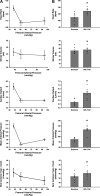Blood flow restriction training activates the muscle metaboreflex during low-intensity sustained exercise
- PMID: 37348015
- PMCID: PMC10393340
- DOI: 10.1152/japplphysiol.00274.2023
Blood flow restriction training activates the muscle metaboreflex during low-intensity sustained exercise
Abstract
Blood flow restriction training (BFRT) employs partial vascular occlusion of exercising muscle and has been shown to increase muscle performance while using reduced workload and training time. Numerous studies have demonstrated that BFRT increases muscle hypertrophy, mitochondrial function, and beneficial vascular adaptations. However, changes in cardiovascular hemodynamics during the exercise protocol remain unknown, as most studies measured blood pressure before the onset and after the cessation of exercise. With reduced perfusion to the exercising muscle during BFRT, the resultant accumulation of metabolites within the ischemic muscle could potentially trigger a large reflex increase in blood pressure, termed the muscle metaboreflex. At low workloads, this pressor response occurs primarily via increases in cardiac output. However, when increases in cardiac output are limited (e.g., heart failure or during severe exercise), the reflex shifts to peripheral vasoconstriction as the primary mechanism to increase blood pressure, potentially increasing the risk of a cardiovascular event. Using our chronically instrumented conscious canine model, we utilized a 60% reduction in femoral blood pressure applied to the hindlimbs during steady-state treadmill exercise (3.2 km/h) to reproduce the ischemic environment observed during BFRT. We observed significant increases in heart rate (+19 ± 3 beats/min), stroke volume (+2.52 ± 1.2 mL), cardiac output (+1.21 ± 0.2 L/min), mean arterial pressure (+18.2 ± 2.4 mmHg), stroke work (+1.93 ± 0.2 L/mmHg), and nonischemic vascular conductance (+3.62 ± 1.7 mL/mmHg), indicating activation of the muscle metaboreflex.NEW & NOTEWORTHY Blood flow restriction training (BFRT) increases muscle mass, strength, and endurance. There has been minimal consideration of the reflex cardiovascular responses that could be elicited during BFRT sessions. We showed that during low-intensity exercise BFRT may trigger large reflex increases in blood pressure and sympathetic activity due to muscle metaboreflex activation. Thus, we urge caution when employing BFRT, especially in patients in whom exaggerated cardiovascular responses may occur that could cause sudden, adverse cardiovascular events.
Keywords: BFR; cardiac rehabilitation; exercise; muscle metaboreflex; ventricular function.
Conflict of interest statement
No conflicts of interest, financial or otherwise, are declared by the authors.
Figures




References
-
- Barbalho M, Rocha AC, Seus TL, Raiol R, Del Vecchio FB, Coswig VS. Addition of blood flow restriction to passive mobilization reduces the rate of muscle wasting in elderly patients in the intensive care unit: a within-patient randomized trial. Clin Rehabil 33: 233–240, 2019. doi:10.1177/0269215518801440. - DOI - PubMed
-
- Davids CJ, Næss TC, Moen M, Cumming KT, Horwath O, Psilander N, Ekblom B, Coombes JS, Peake J, Raastad T, Roberts LA. Acute cellular and molecular responses and chronic adaptations to low-load blood flow restriction and high-load resistance exercise in trained individuals. J Appl Physiol (1985) 131: 1731–1749, 2021. doi:10.1152/japplphysiol.00464.2021. - DOI - PubMed
Publication types
MeSH terms
Grants and funding
LinkOut - more resources
Full Text Sources
Medical

